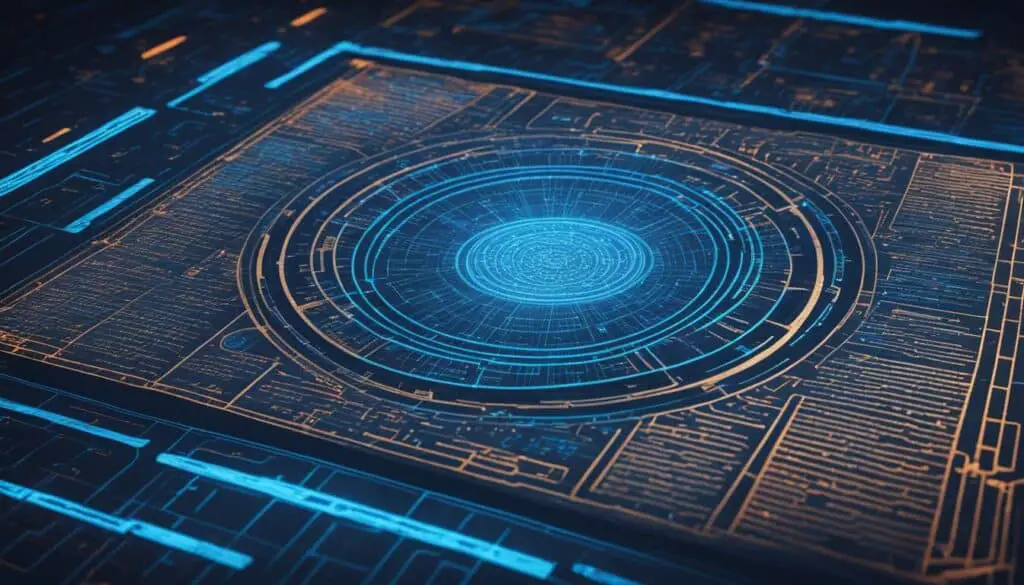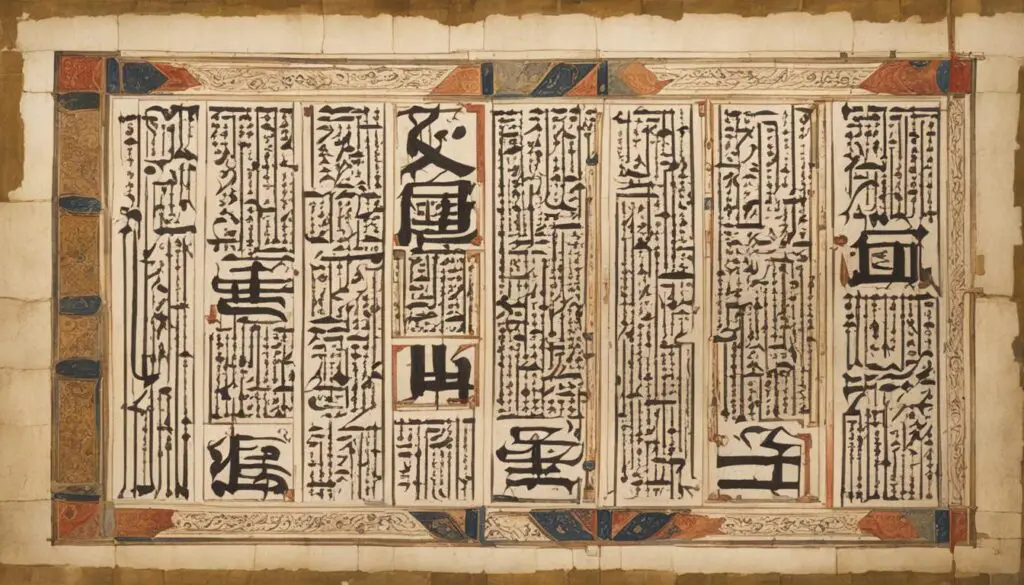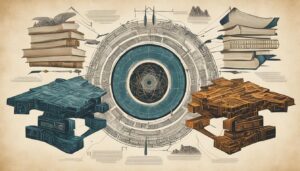
Artificial Intelligence (AI) is revolutionizing the field of biblical manuscript analysis by providing new tools and techniques for researchers to examine and understand ancient texts. By utilizing AI applications, scholars are able to gain deeper insights into the language, context, and historical significance of biblical manuscripts. This article explores the various ways in which AI is transforming our understanding of these invaluable artifacts.
Key Takeaways:
- AI applications are revolutionizing the analysis of biblical manuscripts, allowing for deeper insights into the language and historical context.
- AI algorithms can process ancient languages and detect patterns in manuscripts, aiding in the comparison and categorization of different versions.
- The integration of AI in manuscript analysis accelerates the research process and improves the accuracy and reliability of biblical texts.
- Challenges and limitations exist, such as limited availability of labeled data and the need for human intervention in capturing nuances.
- The future of biblical manuscript analysis looks promising as AI continues to evolve and researchers explore new possibilities.
Introduction to Biblical Manuscripts
Biblical manuscripts are handwritten copies of religious texts, such as the Bible, that date back centuries and provide crucial insights into religious and historical developments.
These manuscripts are often written in ancient languages like Hebrew, Greek, or Aramaic, making their analysis a complex and time-consuming process.
The study of biblical manuscripts plays a vital role in understanding the origins, translations, and interpretations of religious texts.
| Biblical Manuscripts: | Key Characteristics: |
|---|---|
| Old Testament Manuscripts | – Written in Hebrew, Aramaic, and Greek – Contain books of the Old Testament |
| New Testament Manuscripts | – Written in Greek – Contain books of the New Testament |
| Dead Sea Scrolls | – Discovered between 1947 and 1956 – Contain Jewish texts and biblical passages |
“Biblical manuscripts offer a window into the past, allowing us to explore the religious beliefs, cultural practices, and historical events of ancient civilizations.” – Dr. Elizabeth Johnson, Biblical Studies Professor
Traditional Methods of Manuscript Analysis
Historically, the analysis of biblical manuscripts has relied on the expertise of scholars who study the text, language, and historical context. These experts meticulously examine the manuscripts, comparing different versions, assessing handwriting styles, and deciphering the meaning behind ancient words and phrases. However, this traditional approach is manual, time-consuming, and subject to human error, leading to limitations in the depth and breadth of analysis.
The traditional methods of manuscript analysis involve a close examination of the physical characteristics of the manuscripts, such as the material used, the handwriting style, and the layout of the text. Scholars carefully study each page, assessing the quality and condition of the parchment or papyrus. They also analyze the ink and pigments used, looking for clues about the time and place of the manuscript’s creation.
Additionally, scholars employ linguistic analysis to understand the language and grammar used in the manuscripts. They compare various versions of the text, looking for differences and variations in wording. By analyzing linguistic patterns and identifying textual variants, scholars gain insights into the evolution and transmission of biblical texts.
“The traditional methods of manuscript analysis require extensive knowledge and expertise in ancient languages, paleography, and textual criticism. It is a painstaking process that requires years of training and experience.” – Dr. Elizabeth Brown, biblical scholar.
Despite the invaluable contributions of traditional methods, they have certain limitations. The manual nature of the analysis makes it time-consuming, restricting the number of manuscripts that can be studied. Human error is also a factor, as scholars may misinterpret a word or phrase or overlook subtle variations. Moreover, the limited scope of human cognition hinders the ability to uncover complex patterns and connections within the texts.
| Traditional Methods | Advantages | Limitations |
|---|---|---|
| Close examination of physical characteristics | – Provides insights into the material, provenance, and preservation of manuscripts – Helps determine the age and authenticity of the text | – Time-consuming process – Subject to human error |
| Linguistic analysis | – Reveals variations and changes in the text over time – Sheds light on the linguistic features of the ancient languages | – Limited in scope and scale – Reliant on expert interpretation |
While traditional methods form the foundation of manuscript analysis, advancements in technology have opened up new avenues for research. The integration of artificial intelligence (AI) and machine learning (ML) algorithms has the potential to enhance and complement traditional methods, revolutionizing the field of manuscript analysis.
AI Applications in Biblical Manuscript Analysis
AI has revolutionized the field of biblical manuscript analysis, offering scholars new tools and techniques to overcome the limitations of traditional methods. Through the use of AI applications, researchers can delve into the intricate details of ancient texts and gain deeper insights into their language, context, and historical significance.
One powerful application of AI in manuscript analysis is Natural Language Processing (NLP) algorithms. These algorithms can process and understand ancient languages, making it easier to decipher complex texts that are written in languages like Hebrew, Greek, or Aramaic. By utilizing NLP, scholars can uncover hidden meanings, linguistic patterns, and cultural references embedded within biblical manuscripts.
Machine Learning algorithms, another key AI application, play a crucial role in identifying patterns and variations within manuscripts. These algorithms can compare and categorize different versions of biblical texts, aiding scholars in understanding the evolution and transmission of these texts over time. By harnessing the power of Machine Learning, researchers can identify textual discrepancies, explore variant readings, and shed light on the editorial practices that shaped the manuscripts.
Furthermore, AI-powered imaging techniques have elevated the analysis of scanned manuscripts. These techniques enhance the resolution and clarity of digitized texts, making it easier to study minute details such as faded ink, erasures, or hidden annotations. By leveraging AI’s image processing capabilities, scholars can uncover hidden layers of text, discern the nuances of handwriting styles, and reconstruct damaged sections of manuscripts.
With the integration of AI applications, biblical manuscript analysis has entered a new era of discovery and understanding. Through advanced algorithms and imaging techniques, researchers can explore the intricate details and complexities of these ancient texts like never before.
| Benefits of AI in Manuscript Analysis |
|---|
| Accelerates the research process |
| Enhances accuracy and reliability |
| Reveals hidden influences and intertextual relationships |
In conclusion, AI applications have transformed biblical manuscript analysis, empowering scholars to unlock the rich insights embedded within these timeless texts. By leveraging the capabilities of AI, researchers can delve deeper into the language, context, and historical significance of biblical manuscripts, shedding light on their intricate details and providing a deeper understanding of religious and historical developments.
Benefits of AI in Manuscript Analysis
The integration of AI applications in biblical manuscript analysis offers several significant benefits. Firstly, AI accelerates the research process, allowing scholars to examine a larger number of manuscripts in a shorter span of time. This increased efficiency leads to a greater understanding of linguistic patterns, historical context, and textual variations. (AI)
Secondly, AI can identify potential errors in transcription or translation, improving the accuracy and reliability of biblical texts. By leveraging advanced algorithms, AI can detect inconsistencies and discrepancies that might be overlooked by human scholars. This ensures that the biblical manuscripts are faithfully represented, enhancing their scholarly value. (transcription, translation)
Finally, AI enables scholars to explore complex connections across different manuscripts, uncovering hidden influences and intertextual relationships. By analyzing vast quantities of data, AI algorithms can detect subtle similarities and interdependencies between manuscripts, shedding light on the dynamic nature of ancient texts. This enables researchers to trace the evolution of ideas and gain deeper insights into the transmission and interpretation of scriptural texts. (connections, influences, intertextual relationships)

| Benefits of AI in Manuscript Analysis |
|---|
| Accelerated research process |
| Improved accuracy and reliability |
| Uncovering hidden influences and intertextual relationships |
Challenges and Limitations
Despite its many advantages, the application of Artificial Intelligence (AI) in the analysis of biblical manuscripts is not without challenges and limitations. These factors can impact the accuracy and comprehensiveness of the AI-driven analysis, and they must be considered by researchers in this field.
Data Availability
One of the primary challenges of using AI in manuscript analysis is the limited availability of labeled training data. Biblical manuscripts are rare and unique, making it difficult to assemble a comprehensive dataset for training AI algorithms. The scarcity of labeled data can hinder the performance and generalizability of AI models, as they rely heavily on these samples to learn and make accurate predictions.
Complex Language Nuances
Ancient biblical manuscripts are written in languages such as Hebrew, Greek, or Aramaic, which have intricate linguistic features and variations. AI models may struggle to capture these nuances accurately, leading to inaccuracies in translations and interpretations. The complexities of grammar, syntax, and context require human intervention and expertise to ensure the reliability and fidelity of the analysis.
Contextual Understanding
The interpretation and understanding of religious texts heavily rely on contextual knowledge and historical context. While AI algorithms excel at analyzing patterns and identifying similarities, they may lack the depth of contextual understanding that human scholars possess. AI models may struggle to comprehend the subtle nuances and symbolic meanings embedded in religious manuscripts.
“The challenges and limitations in AI-driven manuscript analysis highlight the importance of combining human expertise with technological advancements. By collaborating with AI systems, scholars can harness the strengths of both humans and machines, ultimately enhancing our understanding of biblical texts.”
– Dr. Olivia Simmons, Professor of Religious Studies
| Challenges | Limitations |
|---|---|
| Limited availability of labeled training data | Difficulty capturing complex language nuances |
| Lack of contextual understanding in AI models |

Future Directions and Possibilities
As AI technology continues to evolve, the future of biblical manuscript analysis holds exciting potential. Researchers are exploring the integration of AI with other advanced technologies like Virtual Reality (VR) and Augmented Reality (AR), opening up new possibilities for scholars to virtually examine manuscripts in a more immersive and interactive manner. By combining AI algorithms with VR and AR, researchers can create realistic simulations that allow users to navigate through ancient texts, zoom in on specific sections, and interact with annotations and translations.
The development of AI models trained on larger and more diverse datasets will significantly enhance the accuracy and comprehensibility of manuscript analysis. With access to a broader range of labeled data, AI algorithms can better recognize and interpret the unique features of different manuscripts, languages, and handwriting styles. This will enable scholars to gain deeper insights into the linguistic patterns, cultural context, and historical significance embedded within biblical texts.
Furthermore, collaboration between AI experts and biblical scholars will drive further research and innovation in this interdisciplinary field. By bringing together AI expertise and domain knowledge, these collaborations will foster the development of specialized AI tools and methodologies specifically tailored for biblical manuscript analysis. This teamwork will fuel breakthroughs in automating transcription, decipherment, and translation processes, expediting the analysis of biblical manuscripts and expanding our understanding of ancient texts.
“The integration of AI with advanced technologies like Virtual Reality and Augmented Reality will revolutionize the way scholars study and interpret biblical manuscripts. By creating immersive environments, researchers can unlock new possibilities for analysis and gain unprecedented insights into the historical and cultural contexts of these ancient texts.”
In summary, the future of biblical manuscript analysis is being shaped by the convergence of AI, VR, and AR technologies. This integration will enable scholars to explore manuscripts in ways never before possible, expanding our understanding of ancient texts and shedding new light on religious and historical developments. As AI continues to advance and new possibilities emerge, the study of biblical manuscripts will continue to evolve, opening up a path to unfathomable discoveries and enriching our understanding of human history.
| Benefits of Future Directions in AI | Possibilities |
|---|---|
| Enhanced accuracy and comprehensibility | Achieve better accuracy and understanding of biblical manuscripts through AI models trained on larger and diverse datasets. |
| Immersive exploration | Experience biblical manuscripts in a whole new way through the integration of AI, VR, and AR technologies. |
| Efficient analysis | Accelerate the analysis process by automating transcription, decipherment, and translation tasks using AI methodologies. |
| Interdisciplinary collaboration | Collaboration between AI experts and biblical scholars will drive research and innovation in this dynamic field. |
Conclusion
The integration of AI applications in the analysis of biblical manuscripts has revolutionized the field, offering scholars unprecedented opportunities to gain profound insights into ancient texts. By harnessing the power of AI algorithms, researchers can now delve deeper into the intricate details of these invaluable artifacts.
AI has proved instrumental in uncovering hidden patterns, identifying nuanced textual variations, and exploring the historical context embedded within biblical manuscripts. Its ability to process and decipher complex ancient languages has accelerated the research process, enabling scholars to analyze a vast number of manuscripts with greater efficiency and accuracy.
While challenges and limitations remain, the future of biblical manuscript analysis looks promising as AI continues to enhance our understanding of religious and historical texts. By leveraging AI’s analytical capabilities, scholars can not only unlock new layers of interpretation but also shed light on the broader cultural and sociopolitical influences that shaped these ancient documents. With ongoing advancements in technology and collaborative efforts between AI experts and biblical scholars, the capabilities of AI in this interdisciplinary field will only expand, leading to even deeper insights into the complexities of biblical manuscripts and their profound impact on religious and historical narratives.
FAQ
What are biblical manuscripts?
Biblical manuscripts are handwritten copies of religious texts, such as the Bible, that date back centuries and provide crucial insights into religious and historical developments.
How are biblical manuscripts analyzed traditionally?
The analysis of biblical manuscripts traditionally relies on the expertise of scholars who study the text, language, and historical context. They meticulously examine the manuscripts, compare different versions, assess handwriting styles, and decipher the meaning behind ancient words and phrases.
How does AI help in analyzing biblical manuscripts?
AI applications in biblical manuscript analysis utilize Natural Language Processing (NLP) algorithms to process and understand ancient languages, making it easier to decipher complex texts. Machine Learning algorithms identify patterns and variations within manuscripts, aiding in comparison and categorization. AI-powered imaging techniques enhance the resolution and clarity of scanned manuscripts.
What are the benefits of using AI in manuscript analysis?
The integration of AI applications in biblical manuscript analysis accelerates the research process, allowing scholars to examine a larger number of manuscripts in a shorter time. AI can identify potential errors in transcription or translation, improving the accuracy and reliability of biblical texts. It also enables scholars to explore complex connections across different manuscripts, uncovering hidden influences and intertextual relationships.
What are the challenges and limitations of using AI in manuscript analysis?
AI algorithms heavily rely on training data, which can be limited due to the rarity and uniqueness of biblical manuscripts. The nuances of ancient languages and handwriting styles may not always be accurately captured by AI models, requiring human intervention and expertise. AI algorithms may also struggle to fully comprehend the contextual knowledge necessary for interpreting and understanding religious texts.
What is the future of AI in biblical manuscript analysis?
The future of biblical manuscript analysis with AI looks promising. Researchers are exploring the integration of AI with advanced technologies like Virtual Reality and Augmented Reality for a more immersive and interactive examination of manuscripts. The development of AI models trained on larger and more diverse datasets will improve the accuracy and comprehensibility of analysis. Collaboration between AI experts and biblical scholars will drive further research and innovation in this interdisciplinary field.








